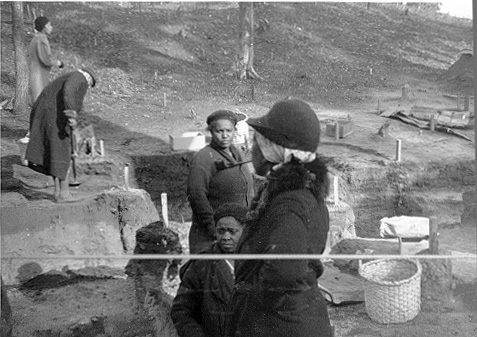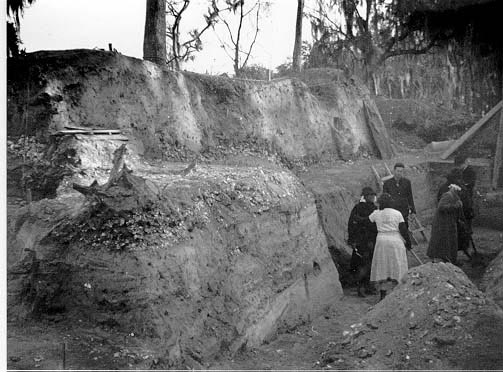The Irene mounds were located five miles northwest of downtown Savannah in Chatham County, and are now completely destroyed; they lie under the ship docks controlled by the Georgia Ports Authority. The site, however, was almost completely excavated by professional archaeologists from 1937 to 1940 as part of the Works Progress Administration, or WPA, archaeological excavations conducted in many places across Georgia. Its importance rests on the fact that it was the most completely excavated mound site in Georgia.
Irene was occupied primarily during the Middle Mississippian period (A.D. 1100-1350) but also was occupied in the Late Mississippian period (A.D. 1350-1600). Although the date is uncertain, it likely had been abandoned before Europeans began visiting the coast of Georgia. Mound sites like Irene were quite common in the Georgia Piedmont but rare on the Georgia coast. While it is certain that its residents grew corn and beans, such coastal resources as fish and shellfish were also clearly vital to their economy.

Reprinted by permission of the Coastal Georgia Archaeological Society
The major features of the site included a large rectangular, flat-topped mound called the Temple Mound; a small conical mound with much shell and several burials called the Burial Mound; and a square building and surrounding wall at ground level in the village with many burials named the Mortuary. The site also included a series of concentric circular walls interpreted as a rotunda, and a few other small buildings or houses scattered in the village area. Shell middens and other food debris were found liberally scattered throughout the site.
The Irene site was perched directly on the bank of the Savannah River and bounded on two sides by Pipemakers Creek and on the third side by a small ditch. It was named after a small mission and school for the Indians established by the Moravians in 1736. Remnants of the school were located on the summit of the Temple Mound during the 1930s excavations. The research at Irene was led by several important archaeologists, the most important of whom was Joseph R. Caldwell. He published an influential account of the site in 1941, and much has also been written of the high quality of the excavations by a workforce of all African American women.

Reprinted by permission of the Coastal Georgia Archaeological Society
The Irene site is now best interpreted as a Chiefly Compound, a special location normally inhabited only by a chief and his family, wives, and children. Thus the total full-time resident population may have been as few as thirty to forty people. The compound also served as a social center for all the other families that lived nearby, likely in individual farmsteads. The rotunda served for much of the society as a meeting place where issues of the day could be discussed. It is likely that the site also functioned as a gathering place for parties and celebrations by much of the population.






